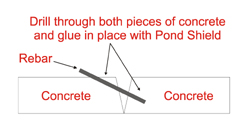
Over time, the concrete in your pond can crack. Ground movement, concrete shrinkage,  freeze/thaw conditions can all play a part in possible cracks forming in your pond. The trouble is that when this happens, you have to go out there and fix the cracked concrete.
freeze/thaw conditions can all play a part in possible cracks forming in your pond. The trouble is that when this happens, you have to go out there and fix the cracked concrete.
So how do you go about fixing cracked concrete in your pond? Well that all depends upon the type of crack as well as the size of the crack in your pond as well as the size of the crack. Cracks can be anything from small hairline cracks up to large fissures that go right through the entire structure.
Concrete Hairline Crack Repair
The simplest of cracks is just a hairline crack. You can perform a hairline crack repair easily using materials such as the Pond Shield Crack RX. However, using the wrong materials can easily lead to that hairline crack turning into something worse.
Far worse simply means more resources to affect the repair. Cash and time are things everyone wants to avoid dumping into repairs so taking your time to think the situation through is very important.
Let’s say you have a crack in your pond that needs to be fixed. The first thing you should try and do is determine how bad the structure has been affected. If it is a hairline crack, it probably does not go through the entire structure, which is good for you.
If the crack goes through the structure you might have your work cut out for you. In severe cases, there isn’t a lot of repair that can be done. But those instances are pretty rare if the structure was made using all of the proper elements needed for good, sound construction.
There are several types of materials that can be used for repairing cracks in your concrete pond, including, more concrete, concrete strengthening additives, bonding agents, rebar, steel mesh, epoxy and fiberglass.
Most people tend to lean towards applying some sort of rubberized caulk into the crack. The problem there is that rubberized coatings or caulks do not bond very well to concrete and can peel.
You also end up with a crack repair that continues to move and can eventually fail again. You really need to shore up the concrete so that it acts just like it was when the crack did not exist.
For hairline cracks, an epoxy like Pond Shield can be used to coat over the crack. Coating over a hairline crack will give you the most minimal resistance to the crack reappearing. I suggest filling the crack with Pond Shield Crack RX. If the crack needs to be cleaned out some, a thin cutting wheel on a grinder can be used to cut straight down inot the crack about ¼ inch deep. This is not a necessity, but may be required if you find it difficult to get the Crack RX into the crack.
What you end up with that repair is essentially a crack that is glued back together. The Crack RX holds the crack from both facing sides and then the crack can be covered with Pond Shield epoxy. The bond strength of Crack RX combined with its elongation break strength of Pond Shield epoxy (9,500 psit) will hold the concrete as though it were one piece.
Big Concrete Crack Repair
For bigger concrete cracks, like those that are a half-inch or so wide, you’ll have to consider more drastic measures. You may find yourself cleaning up the concrete crack quite a bit by actually removing portions of concrete so that you can place new concrete into the affected area.

After the stitch is in place, you can use concrete to fill in the crack. Your concrete can have fibrous additives in it that will act as a strengthener. Be sure to use a good bonding agent on concrete before filling it in. This will aid in the adhesion between the old concrete and the new concrete.
Once the concrete has set up and cured properly, cut the rebar off that is sticking out of the concrete. Make sure to try and cut it lower than the surface of the concrete. Then apply the epoxy to seal the rebar and prevent any corrosion.
Because concrete is porous, I recommend that you coat the entire surface that will be submerged in water. This will keep the water from soaking through the concrete and reaching the rebar beneath where it can corrode there too.
For added strength, you can also apply a strip of fiberglass over the crack. Just apply the strip while the Pond Shield is still wet and saturate it out completely. Once cured, the complete repair will be much stronger than the original concrete was.
Bear in mind that with any pond coating application you will want to make sure that the concrete has been properly acid etched prior to the repair. Surface Prep is a great solution for this as it is user friendly as well as eco friendly. It is biodegradable and is much safer method of cleaning than using other types of acids.


